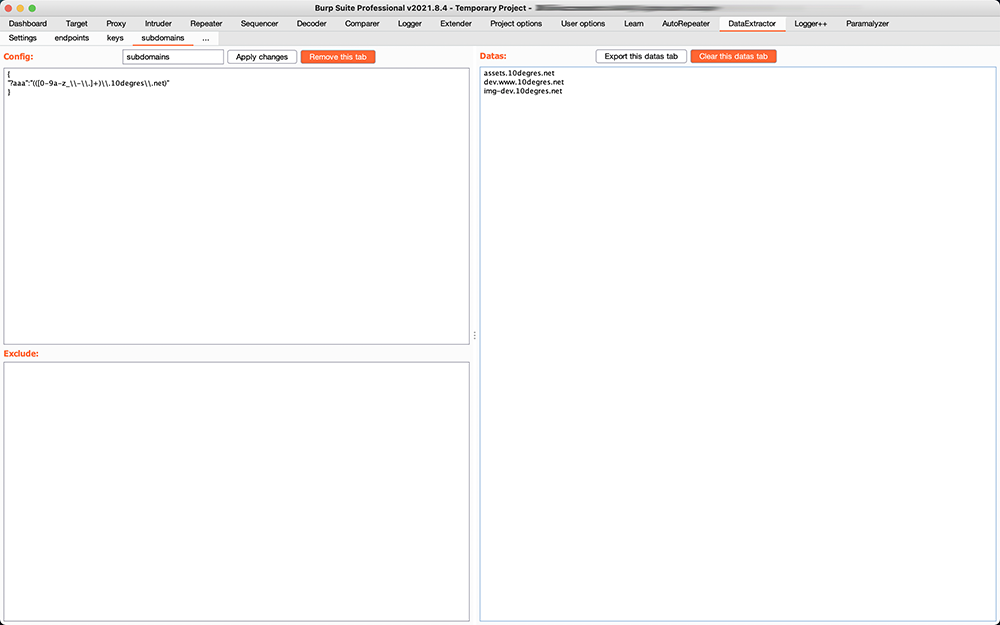A simple Burp Suite extension to extract datas from source code.
- in scope parsing
- file extensions to ignore
- files exclusion based on regexp
- multi tabs for multiple purpose
- datas extraction based on regexp
- results exclusion based on regexp
- datas export
First of all, ensure you have JPython loaded and setup before installing.
- clone this repository
- in the Extender tab, click the button "Add"
- set "Extension type" to "Python"
- browse to the cloned folder and select
DataExtractor.pyas the "Extension file"
The extension should load and is now ready to perform a passive scan.
-
A single click on any "Apply changes" button will save all your settings
-
Settings / Follow scope rules: do not parse out of scope urls as defined in the target scope tab
-
Settings / Remove duplicates: remove duplicates from datas tabs
-
Settings / Ignore extensions: do not parse urls with those extensions
-
Settings / Ignore files: do not parse those files (regexps allowed), JSON format: ["jquery.min.js",".png",...]
important: regexps here are case insentitive by design -
Custom tab / Config: list of regexps to search, JSON format: {"key1":"regexp1","?key2":"regexp2",...}
if the first character of the key is a '?'or a '*', the key will not be printed in the datas tab
important: regexps here are NOT case sentitive, use "(?i)" as a prefix of the whole regexp to make it insentitive
important: you should have at least 1 group configured using parenthesis "()" to be able to catch something, group(1) is used as a result so to ignore a group, please use "?:" as a prefix of the group itself -
Custom tab / Remove from results: remove those results from datas tab (regexps allowed), JSON format: ["http://$","application/javacript",...]
important: regexps here are case insentitive by design
All config textareas should be valid JSON format associative arrays (key/value), so take care of every single comma and quote.
As soon as you save your settings, a check is performed so you can ensure that everything is fine in the output/errors tab of the exender tab.
Note that all keys should be different.
Subdomains (case insensitive):
{
"*dummykey1":"(?i)(([0-9a-z_\\-\\.]+)\\.github\\.com)"
}
AWS keys ans Slack tokens (case sensitive):
{
"slack token": "(xox[pboa]-[0-9]{10,12}-[0-9]{10,12}(-[0-9]{10,12})?-[a-zA-Z0-9]{24,32})",
"aws key": "((AKIA|A3T|AGPA|AIDA|AROA|AIPA|ANPA|ANVA|ASIA)[A-Z0-9]{12,})"
}
See the file myregexp to get all my regexps.
All ignore/remove textareas should be valid JSON format arrays, so take care of every single comma and quote. As soon as you save your settings, a check is performed so you can ensure that everything is fine in the output/errors tab of the exender tab.
[
".png$",
"application/javascript",
"googleapis.com",
"sha256.*$"
]



